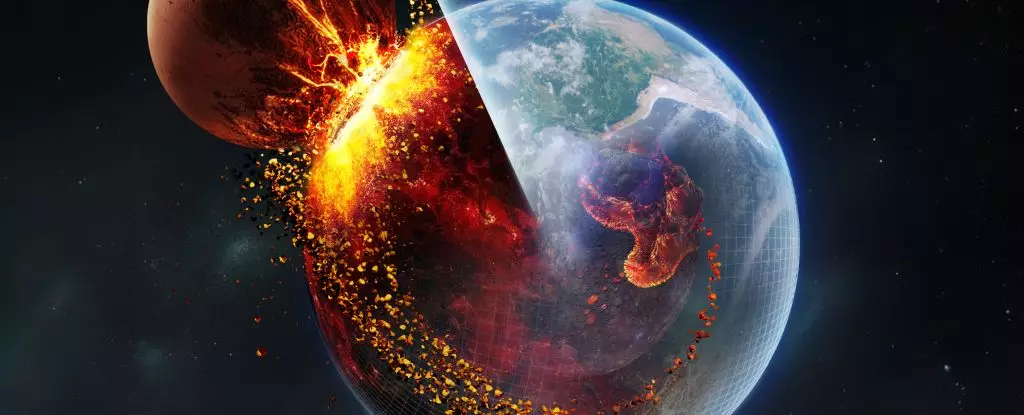Scientists have long believed that a massive collision between Earth and a Mars-sized object called Theia, around 4.5 billion years ago, gave birth to the Moon. However, recent research conducted by teams from China, the US, and the UK has shed new light on this theory. Contrary to previous assumptions, evidence now suggests that not only did chunks of Theia end up inside the Moon but also within Earth itself. This discovery brings us closer to solving a longstanding mystery – the existence of large low-shear-velocity provinces (LLVPs) deep beneath Earth’s surface. These findings challenge conventional thinking and position the Moon-forming giant impact as the catalyst for Earth’s geological evolution over billions of years.
Large low-shear-velocity provinces, or LLVPs, are dense, continent-sized structures encircling Earth’s core-mantle boundary. Scientists have puzzled over the origin of these anomalies, proposing various internal Earth processes as their cause, such as ancient tectonic slabs or temperature anomalies. However, the recent study suggests a different perspective – that Theia’s remnants contributed to the formation of these LLVPs. By analyzing seismic data, researchers have been able to obtain detailed maps of the LLVPs, with one located beneath Africa and another beneath the Pacific Ocean. This novel hypothesis opens up a new realm of possibilities in our understanding of Earth’s composition.
Previous simulations had indicated that most of Theia became part of the Moon, leaving only trace amounts within Earth. However, the latest research challenges this notion. The team carried out extensive computer simulations of the impact, discovering compelling evidence suggesting that a significant portion of Theia may have remained embedded within Earth. The researchers observed the effects of Theia’s impact on the composition of their simulated Earth and identified several crucial indications supporting this alternative narrative.
One significant finding of the simulations is the stratification of Earth’s mantle, with Theia and Earth material mixing in the upper mantle, resembling a liquid magma ocean. In contrast, the lower mantle remained relatively solid, mainly composed of pure silicate Earth material. This stratification, corroborated by seismic data, possibly persists to this day. The implications of this discovery are profound, highlighting the lasting influence of Theia’s impact on Earth’s geological structure.
The simulations also shed light on the formation of LLVPs. According to the research, fragments of Theian material, measuring only tens of kilometers in size, might have descended to Earth’s core-mantle boundary, where they conglomerated and evolved into the LLVPs. The team estimates that approximately 2 to 3 percent of Earth’s mass could originate from Theia. The LLVP material is expected to be 2 to 3.5 percent denser than Earth’s mantle, and it contains a higher iron concentration. This provides an exciting avenue for further investigation, as future lunar missions could potentially collect lunar mantle rocks and compare them with the mantle blobs on Earth to discern shared chemical signatures.
If the upcoming analyses confirm the shared chemical signatures between the lunar mantle rocks and the LLVPs on Earth, it would revolutionize our understanding of our planet’s history, formation, and the larger context of the Solar System. By examining the enigmatic remnants of Theia within Earth, scientists gain valuable insights into the processes that shaped our planet over billions of years. Furthermore, this newfound perspective can be applied to the study of other celestial bodies, aiding our understanding of their habitability and the formation of exoplanets in the Milky Way and beyond.
The scarcity of exoplanets resembling Earth in the Milky Way remains an intriguing mystery. However, the giant impact theory offers a plausible explanation for Earth’s distinctive features. The tremendous collision with Theia billions of years ago transformed our planet’s composition, setting it apart from its celestial neighbors. Reevaluating the impact hypothesis presents an opportunity to appreciate Earth’s uniqueness and enhance our comprehension of the cosmic forces that have shaped our existence.
This groundbreaking research unveiling Theia’s traces within Earth and the formation of LLVPs challenges conventional notions and invites researchers to reassess their understanding of Earth’s geological evolution. By delving into the remnants of the past, scientists can unlock the secrets of Earth’s formation and extend our knowledge to other corners of the universe. The ongoing exploration of Theia’s legacy opens new doors to unraveling the mysteries of our planet and beyond.



Leave a Reply